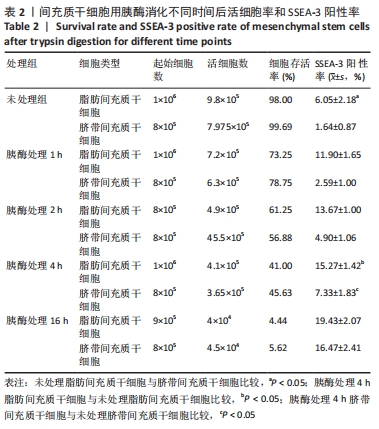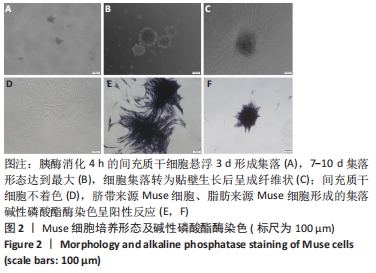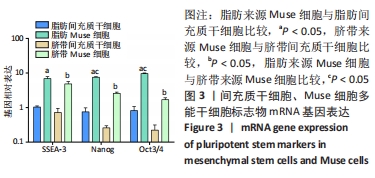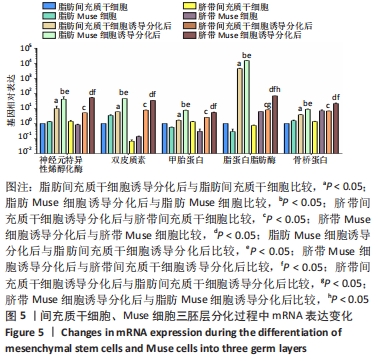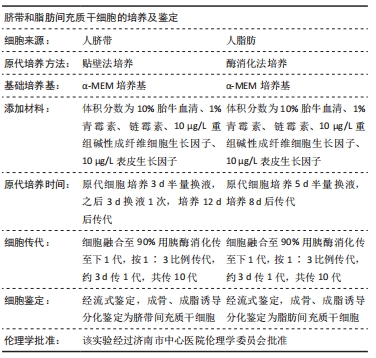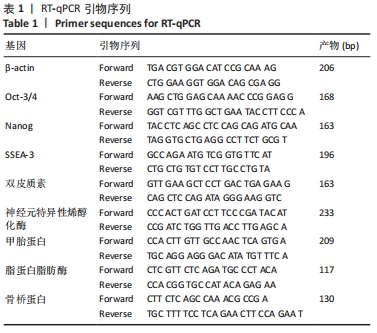中国组织工程研究 ›› 2022, Vol. 26 ›› Issue (24): 3802-3807.doi: 10.12307/2022.557
• 脐带脐血干细胞 umbilical cord blood stem cells • 上一篇 下一篇
人脐带与人脂肪间充质干细胞中应激耐受多系分化细胞的分离鉴定及分化能力比较
张 坤1,2,李 芳1,2,肖东杰1,2,汪运山1,2,黄国宝3,刘 华1,2
- 1山东大学附属济南市中心医院细胞治疗中心,山东省济南市 250013;2山东省移植与组织工程技术研究中心,山东省济南市 250013;3济南市中心医院烧伤整复外科,山东省济南市 250013
Isolation, identification, comparison of the differentiation ability of multilineage-differentiating stress-enduring cells from human umbilical cord derived and adipose derived mesenchymal stem cells
Zhang Kun1, 2, Li Fang1, 2, Xiao Dongjie1, 2, Wang Yunshan1, 2, Huang Guobao3, Liu hua1, 2
- 1Cell Therapy Center, Jinan Central Hospital, Shandong University, Jinan 250013, Shandong Province, China; 2Shandong Research Center of Transplantation and Tissue, Jinan 250013, Shandong Province, China; 3Department of Burn and Plastic Surgery, Jinan Central Hospital, Jinan 250013, Shandong Province, China
摘要:
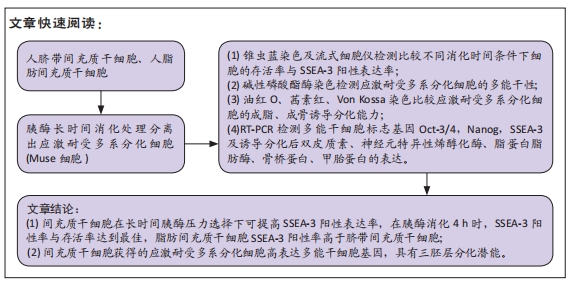
文题释义:
间充质干细胞:是一类具有自我更新能力及多向分化潜能的多能干细胞,具有取材方便、易扩增、低免疫原性等特点,但其主要依靠分泌功能发挥组织修复能力,分化为组织修复细胞的能力有限。
Muse细胞:是一种具有自我更新和多向分化潜能、可向3个胚层分化的细胞,能从皮肤、脂肪、骨髓中获得,也可从间充质干细胞中分离得到,有不断自我更新能力、低端粒酶活性和非致瘤性,而且在体内能整合到损伤部位,具有较强的组织修复能力,是组织工程、细胞移植及基因治疗领域的理想种子细胞。
背景:多系分化应激耐受(multilineage-differentiating stress-enduring,Muse)细胞是一种具有自我更新和多向分化潜能、可向3个胚层分化的细胞,并且具有非致瘤性和低端粒酶活性,是组织工程、细胞移植及基因治疗领域的理想种子细胞,为临床上多种疾病的治疗提供了广阔的前景。
目的:探讨脐带间充质干细胞与脂肪间充质干细胞分选获得的Muse细胞的生物学特性,为临床研究获得足量的Muse细胞提供实验数据。
方法:胰酶长时间消化处理脐带间充质干细胞、脂肪间充质干细胞,锥虫蓝染色及流式细胞仪检测比较不同消化时间下两种细胞的存活率与SSEA-3表达阳性率;通过悬浮贴壁法获取Muse细胞,碱性磷酸酯酶染色检测获取Muse细胞的多能干性,Muse细胞在不同诱导分化液作用下进行多系分化,油红O、茜素红、Von Kossa染色检测比较成脂、成骨诱导分化能力,RT-PCR检测多能干细胞标志基因Oct-3/4,Nanog,SSEA-3的表达及Muse细胞诱导分化后双皮质素、神经元特异性烯醇化酶、脂蛋白脂肪酶、骨桥蛋白、甲胎蛋白的表达变化。
结果与结论:①随着胰酶消化时间的延长,脐带间充质干细胞、脂肪间充质干细胞存活率下降,SSEA-3阳性率上升;②悬浮贴壁获得的Muse细胞碱性磷酸酯酶染色呈阳性反应,间充质干细胞碱性磷酸酯酶染色阴性;③Muse细胞SSEA-3、Nanog、Oct-3/4基因表达水平明显高于间充质干细胞,与脐带来源Muse细胞相比,脂肪来源Muse细胞Nanog、Oct-3/4基因表达增加;油红O、茜素红、Von Kossa染色结果显示Muse细胞成脂、成骨能力高于间充质干细胞;④间充质干细胞及Muse细胞在成脂、成骨诱导培养液、神经元细胞诱导液、肝细胞诱导液作用下分化效率不一样,但均高表达脂蛋白脂肪酶、骨桥蛋白、神经元特异性烯醇化酶、双皮质素及甲胎蛋白,Muse细胞相关基因表达高于间充质干细胞;⑤实验结果证明,脐带间充质干细胞、脂肪间充质干细胞在胰酶消化4 h时,SSEA-3阳性率与存活率达到最佳,脂肪间充质干细胞SSEA-3阳性率高于脐带间充质干细胞。脐带间充质干细胞、脂肪间充质干细胞分选获得的Muse细胞高表达多能干细胞基因,具有三胚层分化潜能。
缩略语:多系分化应激耐受细胞:multilineage-differentiating stress-enduring,Muse细胞
https://orcid.org/0000-0002-8591-9205(刘华)
中国组织工程研究杂志出版内容重点:干细胞;骨髓干细胞;造血干细胞;脂肪干细胞;肿瘤干细胞;胚胎干细胞;脐带脐血干细胞;干细胞诱导;干细胞分化;组织工程
中图分类号:
